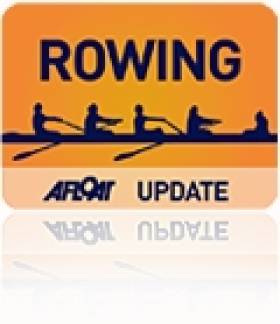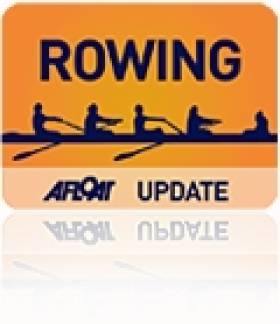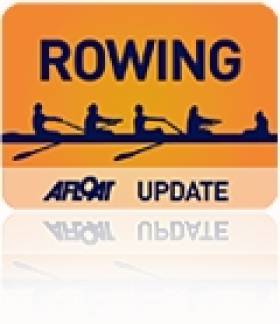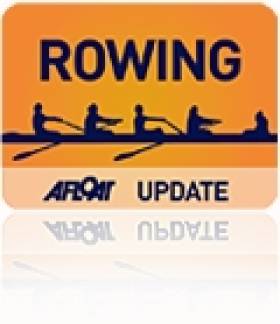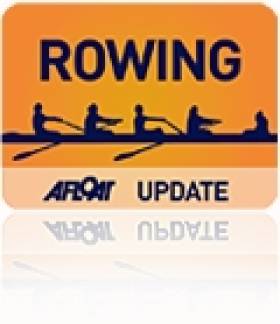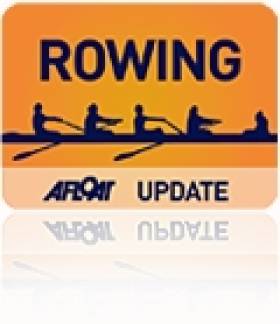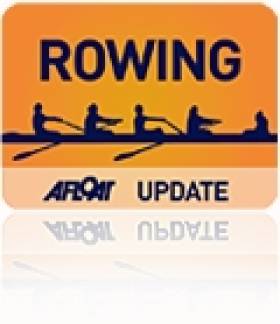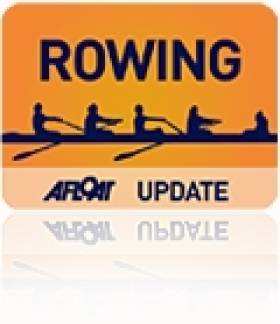Displaying items by tag: O'Donovan
#ROWING: The men’s junior coxed four was the standout race of the morning session at the Irish Rowing Championships at the National Rowing Centre in Cork today. It took a photo finish to confirm Cork Boat Club’s win over Presentation, with Portora also disputing the lead right to the last 50 metres.
Cork Boat Club also took the women’s junior single sculls title through Oisin Forde, who won a fine battle with Jasmine English of Belfast Boat Club. Forde is from Torrevieja in Spain and with her sister Dervla, who was third, will represent Ireland at the Coupe de la Jeunesse next month.
The men’s senior pair final gave Mark O’Donovan and Niall Kenny of UCD a chance to show why they are in the frame to represent Ireland at the World Championships this year, while a former international Fiola Foley partnered a current one, Monika Dukarska to win the women’s intermediate doubles title.
Irish Rowing Championships, National Rowing Centre, Cork (Selected Results; Finals)
Men
Eight – Intermediate: 1 Trinity 5:46.25, 2 NUIG 5:50.28, 3 UCD 5:56.96.
Four, coxed – Junior: 1 Cork BC 6:35.99, 2 Presentation 6:36.22, 3 Portora 6:38.08.
Pair – Senior: 1 UCD (M O’Donovan, N Kenny) 6:46.05, 2 NUIG 6:49.95, 3 Commercial B 7:00.16.
Sculling
Single: Lee (D O’Sullivan) 7:31.80, 2 St Michael’s (P O’Connor) 7:36.24, 3 Belfast BC (A Murray) 7:39.44.
Women
Eight – Novice: 1 Queen’s 7:19.74, 2 Trinity 7:55.75.
Sculling, Double – Intermediate: 1 Killorglin (F Foley, M Dukarska) 7:17.17, 2 Commercial 7:20.83, 3 Skibbereen 7:39.99.
Single – Junior: 1 Cork BC (O Forde) 8:06.14, 2 Belfast BC (J English) 8:07.11, 3 Commercial B 7:00.16.
Ireland Team For World Under-23 Rowing Named
#ROWING: Rowing Ireland has announced the crews which will compete at the Under-23 World Rowing Championships in Varese, Italy, from 23rd to 27th July.
Denise Walsh will compete in the lightweight single scull. Walsh, who is 22 years old, competed in the same event last year, finishing sixth. She has been competing more recently in a newly formed lightweight double scull with Claire Lambe. They finished in 5th position in the B final in their first outing two weeks ago at World Cup II in Aiguebelette. Denise Walsh rows for Skibbereen Rowing club and is in her final year of studying Economics and Geography at UCC.
Paul O’Donovan finished in third place in U23 lightweight men’s scull in Linz, Austria in 2013. He comes from a strong family of rowers, with his father, Teddy, involved in Skibbereen rowing Club. Paul rowed himself since the age of seven. In the recent World Cup II regatta in Aiguebelette Paul won the B final.
Paul’s brother Gary will compete in the men’s lightweight double, together with fellow Skibbereen man Shane O’Driscoll. Gary is passionate about the sport. “My father always had an interest in rowing and he would bring myself and Paul to a lot of rowing events before we started rowing, which we enjoyed a lot,” Gary recalled. “When I was 10 years old, he brought me and Paul rowing for the first time. Since then we have never stopped.”
Shane O’Driscoll, who was in Gary’s class in school, started rowing shortly afterwards and they have rowed together since.
The men’s four from Galway will be hoping for a good result. Many of the crew have rowed since they were at junior level. Richie Bennett and Rob O’Callaghan competed in the four at last year’s Under-23 World Championships, where they finished ninth. Fionnán McQuillan-Tolan recently lined out in the Boston College eight at the Eastern Sprint regatta. Tolan started rowing at St Joseph’s College and won three junior Championships with them.
Ireland Under-23 World Championship Team:
Men
Four: Fionnán McQuillan-Tolan (Grainne Mhaol RC), Richard Bennett (NUIG BC), Robert O'Callaghan (NUIG BC), Kevin Neville (NUIG BC). Lightweight Double Scull: Gary O’Donovan (CIT RC), Shane O’Driscoll (Skibbereen RC). Lightweight Single Scull: Paul O’Donovan (UCD).
Women
Lightweight Single Scull: Denise Walsh (Skibbereen RC).
O'Donovan Bosses B Final at World Cup Rowing Regatta
#ROWING: Paul O’Donovan won the B Final of the lightweight single sculls at the World Cup Regatta in Aiguebelette in France this morning. The UCD man was fourth at 500 metres but headed the field in the final quarter and moved clear to win well and secure seventh overall.
The women’s pair of Leonora Kennedy and Lisa Dilleen finished third in their B Final, ninth overall. New Zealand’s Louise Trappitt and Rebecca Scown – who won the A Final at the first World Cup in Sydney – were impressive winners of this race, while Ireland and Canada battled for second, well ahead of Germany One, Britain Two and France.
The Ireland lightweight women’s double scull of Claire Lambe and Denise Walsh finished their first regatta together as a crew fifth in the B Final, 11th overall. China Two won from the United States, Australia and Denmark while behind them Ireland outpaced Brazil all the way down the course.
World Cup Regatta, Aiguebelette, France, Day Three (Irish interest, selected results)
Men
Lightweight Single Sculls – B Final (Places 7 to 12): 1 Ireland One (P O’Donovan) 7:07.46, 2 Azerbaijan (J Afandiyev) 7:08.23, 3 Britain (Z Lee-Green) 7:10.55, 4 France 7:13.96, 5 Algeria 7:17.64, 6 Switzerland 7:19.68.
Women
Pair – B Final (Places 7 to 12): 1 New Zealand (L Trappitt, R Scown) 7:10.55, 2 Canada (N Mastracci, S Grainger) 7:15.16, 3 Ireland (L Kennedy, L Dilleen) 7:16.53, 4 Germany 7:24.64, 5 Britain 7:26.55, 6 France 7:27.64.
Lightweight Double Scull – B Final (Places 7 to 12): 1 China Two (Huan Zhang, Le Chen) 7:11.20, 2 United States (D Karz, M Sechser) 7:12.17, 3 Australia (E Flecker, A McNamara) 7:13.42, 4 Denmark 7:14.02, 5 Ireland (C Lambe, D Walsh) 7:16.71, 6 Brazil 7:23.33.
,
Mark O'Donovan Finishes Well at World Cup Rowing
#ROWING: Mark O’Donovan ended his participation at the World Cup Regatta in Aiguebelette on a high today. He was entered in the lightweight single sculls after his lightweight pairs partner Niall Kenny had to pull out, but O’Donovan won the C Final this morning. His remarkable drive to the line took him past Aymen Mejri of Tunisia, who had dominated the race to that point. The win placed O’Donovan 13th overall.
The women’s double of Monika Dukarska and Eimear Moran finished second in their C Final, 14th overall and John Keohane in the the same position in the D Final of the open single sculls, 20th overall.
World Cup Regatta, Aiguebelette, France, Day Two (Selected Results, Irish interest)
Men
Single Sculls – D Final (Places 19 to 23): 1 Bulgaria 7:14.01, 2 Ireland (J Keohane) 7:16.48, 3 China 7:19.41.
Lightweight Single Sculls – Semi-Final Two (First Three to A Final; rest to B Final): 1 Germany Two (J Schoemann-Finck) 7:00.71, 2 Bulgaria (V Nedelcho) 7:03.69, 3 France (D Piqueras) 7:04.23; 4 Ireland One (P O’Donovan) 7:06.99, 5 Switzerland One 7:14.8, 6 Algeria 7:21.36. C Final (places 13 to 18): 1 Ireland Two (M O’Donovan) 7:17.11, 2 Tunisia One 7:17.40, 3 Switzerland Two 7:19.58.
Women
Double Sculls – C Final (Places 13, 14): 1 France 7:12.84, 2 Ireland (M Dukarska, E Moran) 7:20.78.
#ROWING: Paul O’Donovan finished fourth in the A/B semi-final of the lightweight single sculls at the World Cup in Aiguebelette this morning and will compete in tomorrow’s B Final. The UCD man was fourth at halfway and made a big push in the third quarter, but could not secure a place in the top three.
World Cup Regatta, Aiguebelette, France, Day Two (Selected Results, Irish interest)
Men
Lightweight Single Sculls – Semi-Final Two (First Three to A Final; rest to B Final): 1 Germany Two (J Schoemann-Finck) 7:00.71, 2 Bulgaria (V Nedelcho) 7:03.69, 3 France (D Piqueras) 7:04.23; 4 Ireland One (P O’Donovan) 7:06.99, 5 Switzerland One 7:14.8, 6 Algeria 7:21.36.
O'Donovan Starts World Cup Rowing Campaign With Heat Win
#ROWING: Paul O’Donovan qualified directly for the A/B Semi-Finals of the World Cup Regatta in Aiguebelette in France this morning. The UCD lightweight single sculler was the fastest in his heat, which was run on a time-trial basis. Zak Lee-Green of Britain was second. The fastest two qualified directly.
Mark O’Donovan, rowing in this event after Niall Kenny had to pull out of the originally-entered lightweight pair, was fifth in the in first heat.
The heats were run on a time trial basis to test this out for future events where this format might need to be used.
On Friday evening, Tom Kelly was fifth in his heat of the Arms and Shoulders men's single sculls.
World Cup Regatta, Aiguebelette, France, Day One (Selected Results, Irish interest)
Men
Lightweight Single Sculls – Heats (Time Trials; First Two Directly Through to A/B Semi-Finals; rest to Repechage)
Heat One: 1 China (Tiexin Wang) 7:02.36, 2 France (D Piqueras) 7:07.64; 5 Ireland Two (M O’Donovan) 7:20.78
Heat Three: 1 Ireland One (P O’Donovan) 7:11.34, 2 Britain (Z Lee-Green) 7:15.60.
Pararowing – Arms and Shoulders Men’s Single Sculls – Heat Two (First to A Final; rest to Repechage): 5 Ireland (T Kelly)
O'Donovan Closes Out European Rowing Campaign
#ROWING: Paul O’Donovan finished a close-up second to Petr Cabla of the Czech Republic in the C Final of the lightweight men’s single sculls at the European Rowing Championships in Belgrade in Serbia today. Cabla was an impressive winner, outlasting challenges from Croatia’s Luka Radonic and Slovakia’s Marek Reznak and then O’Donovan in the closing stages to win. He places 13th and O’Donovan 14th of the 20 starters.
European Rowing Championships, Day Two (Irish interest; selected results)
Men
Lightweight Single Sculls – C/D Semi-Final Two: (First Three to C Final): Croatia 7:10.20, 2 Ireland (P O’Donovan) 7:11.13, 3 Slovakia 7:11.54; 4 Netherlands 7:12.19. C Final (Places 7 to 11): 1 Czech Republic (P Cabla) 7:08.92, 2 Ireland (O’Donovan) 7:09.59, 3 Croatia 7:12.18, 4 Slovakia 7:20.10. France did not start.
Women
Pair – Repechage Two (First Two to A Final; rest to B Final): 1
Ireland (L Kennedy, L Dilleen) 7:20.36, 2 Germany 7:22.89; 3 Czech Republic 7:24.99, 4 France 7:36.63
Double – Repechage (First Two to A Final; rest to B Final): 1 Netherlands (N Beukers, I Janssen) 6:54.59, 2 Russia (E Potapova, M Krasilnikova) 6:57.25; 3 Czech Republic 6:58.72, 4 Italy 7:00.87, 5 Austria 7:14.31, 6 Ireland (M Dukarksa, E Moran) 7:19.82.
Single – A/B Semi-Final Two (Two to A Final; rest to B Final): 1 Netherlands (C Achterberg) 7:36.98, 2 Ireland (S Puspure) 7:38.31, 3 Germany (A Thiele) 7:41.36; 4 Ukraine 7:44.95, 5 Sweden 7:45.46, 6 Latvia 7:57.97.
#ROWING: Paul O’Donovan qualified for the C Final (Places 13 to 18) at the European Rowing Championships in Belgrade in Serbia today. The UCD man finished second of the three qualifiers from his C/D semi-final this morning. Croatia and Slovakia both led during the race while O’Donovan held on to second. Croatia’s Luka Radonic came home first, with Marek Reznak of Slovakia third. Fourth-placed Daan Klomp of the Netherlands was the sculler who missed out and will have to go to the D Final.
European Rowing Championships, Day Two (Irish interest; selected results)
Men
Lightweight Single Sculls – C/D Semi-Final Two: (First Three to C Final): Croatia 7:10.20, 2 Ireland (P O’Donovan) 7:11.13, 3 Slovakia 7:11.54; 4 Netherlands 7:12.19.
Tough Second Outing For O'Donovan At European Rowing
#ROWING: Paul O’Donovan, who came within one place of gaining automatic qualification for the A/B semi-finals this morning, could only finish fourth in his repechage at the European Rowing Championships in Belgrade in Serbia this afternoon. The two coveted places in the lightweight single sculls semis went to Slovenia and Serbia. The Czech Republic was third and Ireland fourth. O’Donovan’s next challenge is the C/D semi-finals tomorrow.
European Rowing Championships, Belgrade, Serbia – Day One (Irish interest; selected results)
Men
Lightweight Single Sculls – Heat Three (First Two to A/B Semi-Finals; rest to Repechage): 1 Italy (M Miani) 6:56.92, 2 Bulgaria (N Vasilev) 6:59.35; 3 Ireland (P O’Donovan) 7:02.21, 4 France 7:06.95, 5 Turkey 7:16.58. Repechage (First Two to A/B Semi-Finals; rest to C/D Semi-Finals): 1 Slovenia (R Hrvat) 7:06.58, 2 Serbia (M Stanojevic) 7:09.01; 3 Czech Republic 7:11.62, 4 Ireland (O’Donovan) 7:12.26, 5 Netherlands 7:15.5.
Women
Pair – Heat Two (Winner to A Final; rest to Repechage): 1 Romania (C Grigoras, L Oprea) 7:14.51; 2 Ireland (L Kennedy, L Dilleen) 7:18.77, 3 Croatia 7:21.87, 4 Serbia 7:24.46, 5 Germany 7:32.40.
Double Sculls – Heat Two (First Two to A Final; rest to Repechage): 1 Poland (M Fularczyk, N Madaj) 6:46.50, 2 Britain (F Houghton, V Thornley); 3 Netherlands 6:54.59, 4 Czech Republic 7:10.63, 5 Ireland (M Dukarska, E Moran) 7:16.66.
Single Sculls – Heat Three (First Two to A/B Semi-Finals; rest to Repechage): 1 Czech Republic (M Knapkova) 7:29.98, 2 Netherlands (C Acterberg) 7:31.64; 3 Ireland (S Puspure) 7:39.26, 4 Sweden 7:48.13, 5 Latvia 7:51.24.
O'Donovan Third in Heat at European Rowing Championships
#ROWING: Paul O’Donovan finished third in his heat of the lightweight single sculls, just one place outside automatic qualification for the A/B semi-finals, at the European Championships in Belgrade this morning. In fast cross-tailwind conditions, Italy’s Marcello Miani set a hot pace and won well. France, Bulgaria and Ireland vied for the valuable second spot. O'Donovan put in a good second 1,000 metres, but Bulgaria’s Nedelcho Vasilev took second. France were fourth. Ireland, France and Turkey go to Repechages later in the day.
European Rowing Championships, Belgrade, Serbia – Day One (Irish interest; selected results)
Men
Lightweight Single Sculls – Heat Three (First Two to A/B Semi-Finals; rest to Repechage): 1 Italy (M Miani) 6:56.92, 2 Bulgaria (N Vasilev) 6:59.35; 3 Ireland (P O’Donovan) 7:02.21, 4 France 7:06.95, 5 Turkey 7:16.58.




























